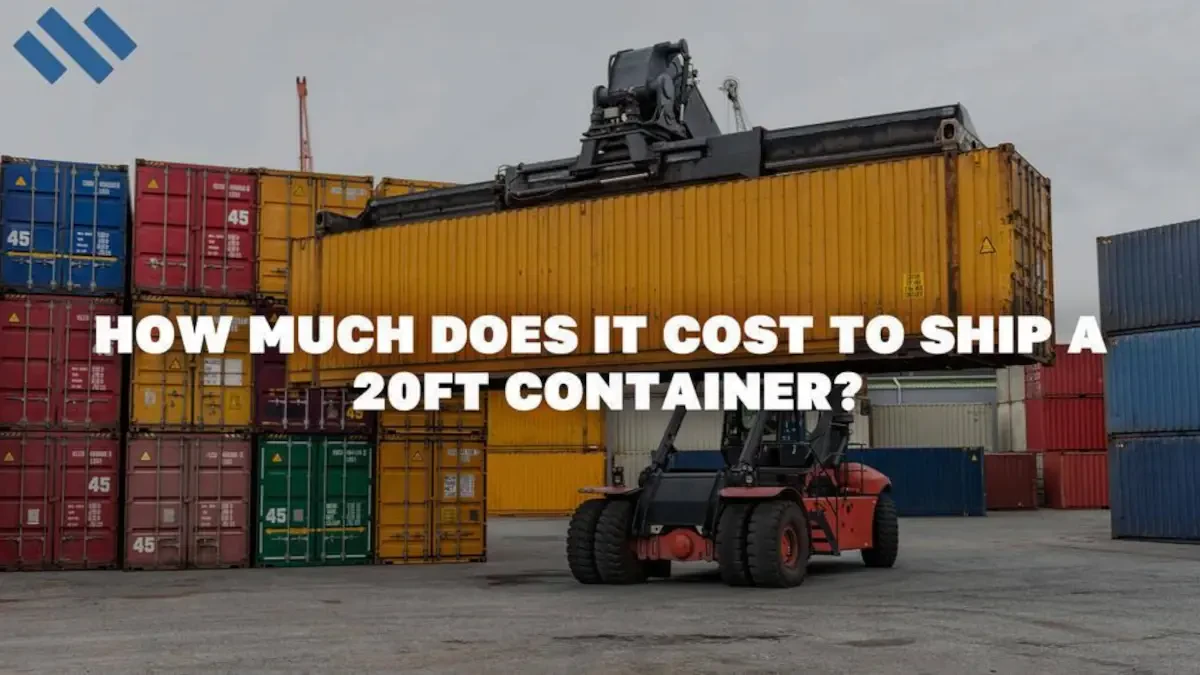Published by Chris Townsend
Last updated Jun, 23 2025

The best way to convey big, heavy products is with delivery containers, often known as sea crates. The cost of transporting one of these units, however, can be high for some shippers. Find out, How much it costs to ship a 20ft unit.
Small shipping crates, or those that measure less than 20 feet long, are excellent if you only have a couple of items you need to store or a small enough space for your unit to sit comfortably. However, it’s important to note that any unit that is less than 20 feet long will generally cost the same as a 20-foot unit. This has to do with the fact that the smallest size transit unit used in the shipping industry is the 20-foot container.
While 10-foot and smaller crates can be used for delivery, modern port equipment cannot lift or move them. The only way that these small containers can be moved is when they are connected to another 10-foot unit to make a standard 20-foot unit. With this in mind, it’ll cost quite a bit more to ship a single 10-foot crate than it would be to transport a 20-foot container anywhere in the world.
What Is The Smallest Size Shipping Container?
With that said, the smallest size container that can be used for shipping is a standard 20-foot unit. These crates measure just under 20 feet long, eight feet wide, and eight feet six inches tall. They have a maximum load of 61,000 pounds and are suitable for shipping the contents of a one- or two-bedroom home.
Also referred to as a ‘Twenty-Foot Equivalent Unit’ (TEU), the 20-foot transit unit is the industry standard. As such, vessel capacity and cargo volume are measured in terms of TEU. Although 20-foot crates are the smallest size shipping container available, the 40-foot container – known as the Forty-Foot Equivalent Unit (FEU) – is the most common crate in use today.
How Much Does It Charge To Haul A Twenty-Feet Unit?
The average cost to ship the smallest crate (20-foot unit), is approximately $3,000. However, your final cost will depend on how much stuff you have to move and where you’re headed, in addition to several other factors. Even things like the moving company you hire and the time of year you move can make a huge difference in cost.
In terms of distance, the charge to haul a 20-foot unit is between $1 and $4 a mile. The shorter the move, the more affordable overall, but you’ll generally have a higher rate per mile. However, keep in mind that each crate shipping company calculates its rates differently. Therefore, the best way to know exactly how much it costs to transit a small container is to request an estimate from a reputable mover.

Factors That Influence Transit Charges
To fully understand how much it costs to transit a small container, you must know what factors make the biggest impact. That said, let’s take a look at some of the most common factors that affect the total charge of shipping a 20-foot container.
LCL vs. FCL
Are you going to need the entire 20-foot unit for your belongings? Or, will you only be able partially to fill it? LCL, or Less than Container Load, describes delivery that doesn’t require the entire crate. Most companies will typically impose a minimum delivery volume, which may be as low as 35.3 cubic feet. For small transit, this is the most cost-effective option since you will be sharing costs with those that whom you are sharing the crates.
Depending on your situation, it may make the most sense financially and logistically to book the full crates. This is known as Full Container Load or FCL. You will be responsible for paying for the entire unit, as your goods will not be combined with other shipments.
Distance
Arguably, distance has the biggest impact on the charge of hauling a 20-foot container. The further that you need to transit the unit, the more it’ll cost you. Most shipping companies raise their rate to account for vehicle maintenance, environmental taxes, fuel charges, and more.
Regardless, a local relocation is always going to cost less than a long-distance move – and especially one that is international/overseas.
Method of Transport
Essentially, there are three main modes of transport when it comes to shipping a 20-foot container, with some being more affordable than others.
- Road: Nearly all types of relocations involve a truck at some point. This is the most expensive method, as shippers must consider maintenance and fuel costs for the journey.
- Rail: Shipping via train is less expensive and very common for moves within a continent.
- Ocean Freight: Ocean freight or hauling via a container transit, is the most cost-effective way to transport a 20-foot unit, but also the slowest. However, keep in mind that if you’re not transporting the crate overseas, you would not use this method.
Depending on your move, you may need to use a combination of these three methods. Shipping containers is all about logistics and while rail is generally cheaper than trucking, it may not always be the case for your situation.
Time of Year
If you plan to ship your 20-foot unit during a time of the year when these services are in high demand, you’ll end up paying more. Peak seasons for the moving industry tend to be the summer and spring months. There is also usually a higher demand on holidays, weekends, and at the beginning and end of the month. Avoid these times of the year and opt for a winter move to make your shipment as affordable as possible.
Are There 10 Foot Delivery Units?
You’re likely familiar with the standard 20- and 40-foot hauling containers. However, did you know that there are, in fact, 10-foot shipping crates available as well? These shipping crates are one of the more unique and rare sizes you can find. They are an excellent storage solution for areas where the more common-sized units cannot fit. The dimensions for a 10-foot shipping container are as follows:
- Width: 8 ft.
- Length: 10 ft.
- Height: 8 ft. six in.
- Weight: 2,900 pounds
10-foot hauling crates have many uses, including locking up your construction materials, keeping your tools protected from the elements, creating a custom office unit, or even housing a DIY sauna. Although you can move 10-foot crates easily around your property as needed, they cannot be hauled easily.
The only way to ship a 10-foot moving unit is to bolt it to another 10-foot container. That way, the equipment at the port can lift and move the unit for transport. So, while there are 10-foot shipping containers out there that can be used for a variety of purposes, they are too small to be used for shipping.
Frequently Asked Questions
When available a 10-foot shipping container will generally run you between $3,000 and $4,500. You might notice that this range is quite a bit higher than 20- or 40-foot containers. This has to do with the fact that 10-foot containers have a more labor-intensive manufacturing process and are very rare.
There are a range of worldwide companies that sell 10-foot shipping containers or will help source this size for you. Though, since they are in a much shorter supply, it may take more time to source one.
A 10-foot shipping container has about 72 square feet of floor space and can hold the contents of a small one-bedroom or roughly two to three rooms. As such, this size container is ideal for students and singles.
how to move a 20ft shipping container shipping container transport cost


